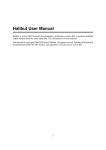Download 0.4.8 PDF - Read the Docs
Transcript
pyte
Release 0.4.8
January 13, 2014
Contents
i
ii
pyte, Release 0.4.8
_
| |
_ __
_
_ | |_ ___
| ’_ \ | | | || __|/ _ \
| |_) || |_| || |_| __/
| .__/ \__, | \__|\___|
| |
__/ |
|_|
|___/
0.4.8
It’s an in memory VTXXX-compatible terminal emulator. XXX stands for a series of video terminals, developed by
DEC between 1970 and 1995. The first, and probably the most famous one, was VT100 terminal, which is now a
de-facto standard for all virtual terminal emulators. pyte follows the suit.
So, why would one need a terminal emulator library?
• To screen scrape terminal apps, for example htop or aptitude.
• To write cross platform terminal emulators; either with a graphical (xterm, rxvt) or a web interface, like AjaxTerm.
• To have fun, hacking on the ancient, poorly documented technologies.
Note: pyte started as a fork of vt102, which is an incomplete pure Python implementation of VT100 terminal.
Contents
1
pyte, Release 0.4.8
2
Contents
CHAPTER 1
Installation
If you have setuptools you can use easy_install -U pyte. Otherwise, you can download the source from
GitHub and run python setup.py install.
3
pyte, Release 0.4.8
4
Chapter 1. Installation
CHAPTER 2
Similar projects
pyte is not alone in the weird world of terminal emulator libraries, here’s a few other options worth checking out:
Termemulator, pyqonsole, webtty, AjaxTerm and of course vt102.
5
pyte, Release 0.4.8
6
Chapter 2. Similar projects
CHAPTER 3
pyte users
Believe it or not, there’re projects which actually need a terminal emulator library, not many of them use pyte though:
• Selectel – hey, we wrote this thing :)
• Ajenti – easy to use weadmin panel for Linux and BSD uses pyte for its terminal plugin.
• Neutron IDE – personal cloud IDE.
7
pyte, Release 0.4.8
8
Chapter 3. pyte users
CHAPTER 4
Show me the code!
Head over to our brief Tutorial or, if you’re feeling brave, dive right into the API reference – pyte also has a couple
of minimal examples in the examples/ directory.
4.1 Tutorial
There are two important classes in pyte: Screen and Stream. The Screen is the terminal screen emulator. It
maintains an in-memory buffer of text and text-attributes to display on screen. The Stream is the stream processor. It
manages the state of the input and dispatches events to anything that’s listening about things that are going on. Events
are things like LINEFEED, DRAW "a", or CURSOR_POSITION 10 10. See the API reference for more details.
In general, if you just want to know what’s being displayed on screen you can do something like the following:
>>>
>>>
>>>
>>>
>>>
>>>
import pyte
screen = pyte.Screen(80, 24)
stream = pyte.Stream()
stream.attach(screen)
stream.feed("Hello World!")
screen.display
[’Hello World!
’
’
’
’
’
’
’
’
’
’
’
’
’
’
’
’
’
’
’
’
’
’,
’,
’,
’,
’,
’,
’,
’,
’,
’,
’,
’,
’,
’,
’,
’,
’,
’,
’,
’,
’,
’,
9
pyte, Release 0.4.8
’
’
’,
’]
Note: Screen has no idea what is the source of bytes, fed into Stream, so, obviously, it can’t read or change
environment variables, which implies that:
• it doesn’t adjust LINES and COLUMNS on "resize" event;
• it doesn’t use locale settings (LC_* and LANG);
• it doesn’t use TERM value and expects it to be “linux” and only “linux”.
4.2 API reference
4.2.1 pyte
pyte implements a mix of VT100, VT220 and VT520 specification, and aims to support most of the TERM=linux
functionality.
Two classes: Stream, which parses the command stream and dispatches events for commands, and Screen which,
when used with a stream maintains a buffer of strings representing the screen of a terminal.
Warning: From xterm/main.c “If you think you know what all of this code is doing, you are probably very
mistaken. There be serious and nasty dragons here” – nothing has changed.
copyright
3. 2011-2013 by Selectel, see AUTHORS for details.
license LGPL, see LICENSE for more details.
4.2.2 pyte.streams
This module provides three stream implementations with different features; for starters, here’s a quick example of how
streams are typically used:
>>>
>>>
>>>
...
...
...
...
...
...
>>>
>>>
>>>
>>>
>>>
5
import pyte
class Dummy(object):
def __init__(self):
self.y = 0
def cursor_up(self, count=None):
self.y += count or 1
dummy = Dummy()
stream = pyte.Stream()
stream.attach(dummy)
stream.feed(u"[5A") # Move the cursor up 5 rows.
dummy.y
copyright
3. 2011-2013 by Selectel, see AUTHORS for details.
license LGPL, see LICENSE for more details.
10
Chapter 4. Show me the code!
pyte, Release 0.4.8
class pyte.streams.Stream
A stream is a state machine that parses a stream of characters and dispatches events based on what it sees.
Note: Stream only accepts strings as input, but if, for some reason, you need to feed it with bytes, consider
using ByteStream instead.
See also:
man console_codes For details on console codes listed bellow in basic, escape, csi and sharp.
basic = {u’\x07’: u’bell’, u’\t’: u’tab’, u’\x08’: u’backspace’, u’\x0b’: u’linefeed’, u’\n’: u’linefeed’, u’\r’: u’carriage_ret
Control sequences, which don’t require any arguments.
escape = {u’c’: u’reset’, u’E’: u’linefeed’, u’D’: u’index’, u’H’: u’set_tab_stop’, u’M’: u’reverse_index’, u‘7’: u’save_cur
non-CSI escape sequences.
sharp = {u‘8’: u’alignment_display’}
“sharp” escape sequences – ESC # <N>.
csi = {u””’: u’cursor_to_column’, u’A’: u’cursor_up’, u’@’: u’insert_characters’, u’C’: u’cursor_forward’, u’B’: u’curs
CSI escape sequences – CSI P1;P2;...;Pn <fn>.
reset()
Reset state to "stream" and empty parameter attributes.
consume(char)
Consume a single string character and advance the state as necessary.
Parameters char (str) – a character to consume.
feed(chars)
Consume a string and advance the state as necessary.
Parameters chars (str) – a string to feed from.
attach(screen, only=())
Adds a given screen to the listeners queue.
Parameters
• screen (pyte.screens.Screen) – a screen to attach to.
• only (list) – a list of events you want to dispatch to a given screen (empty by default, which
means – dispatch all events).
detach(screen)
Removes a given screen from the listeners queue and failes silently if it’s not attached.
Parameters screen (pyte.screens.Screen) – a screen to detach.
dispatch(event, *args, **kwargs)
Dispatch an event.
Event handlers are looked up implicitly in the listeners’ __dict__, so, if a listener only wants to handle
DRAW events it should define a draw() method or pass only=["draw"] argument to attach().
Warning:
aborted.
If any of the attached listeners throws an exception, the subsequent callbacks are be
Parameters
• event (str) – event to dispatch.
4.2. API reference
11
pyte, Release 0.4.8
• args (list) – arguments to pass to event handlers.
class pyte.streams.ByteStream(encodings=None)
A stream, which takes bytes (instead of strings) as input and tries to decode them using a given list of possible
encodings. It uses codecs.IncrementalDecoder internally, so broken bytes is not an issue.
By default, the following decoding strategy is used:
•First, try strict "utf-8", proceed if recieved and UnicodeDecodeError ...
•Try strict "cp437", failed? move on ...
•Use "utf-8" with invalid bytes replaced – this one will allways succeed.
>>> stream = ByteStream()
>>> stream.feed(b"foo".decode("utf-8"))
Traceback (most recent call last):
File "<stdin>", line 1, in <module>
File "pyte/streams.py", line 323, in feed
"%s requires input in bytes" % self.__class__.__name__)
TypeError: ByteStream requires input in bytes
>>> stream.feed(b"foo")
Parameters encodings (list) – a list of (encoding, errors) pairs, where the first element is
encoding name, ex: "utf-8" and second defines how decoding errors should be handeld; see
str.decode() for possible values.
class pyte.streams.DebugStream(to=<open file ‘<stdout>’, mode ‘w’ at 0x7f3e3d4b9150>, only=(),
*args, **kwargs)
Stream, which dumps a subset of the dispatched events to a given file-like object (sys.stdout by default).
>>> stream = DebugStream()
>>> stream.feed("[1;24r[4l[24;1H[0;10m")
SET_MARGINS 1; 24
RESET_MODE 4
CURSOR_POSITION 24; 1
SELECT_GRAPHIC_RENDITION 0; 10
Parameters
• to (file) – a file-like object to write debug information to.
• only (list) – a list of events you want to debug (empty by default, which means – debug all
events).
4.2.3 pyte.screens
This module provides classes for terminal screens, currently it contains three screens with different features:
• Screen – base screen implementation, which handles all the core escape sequences, recognized by Stream.
• If you need a screen to keep track of the changed lines (which you probably do need) – use DiffScreen.
• If you also want a screen to collect history and allow pagination – pyte.screen.HistoryScreen is here
for ya ;)
Note: It would be nice to split those features into mixin classes, rather than subclasses, but it’s not obvious how to do
– feel free to submit a pull request.
12
Chapter 4. Show me the code!
pyte, Release 0.4.8
copyright
3. 2011-2013 Selectel, see AUTHORS for details.
license LGPL, see LICENSE for more details.
class pyte.screens.Cursor(x, y, attrs=_Char(data=u’ ‘, fg=u’default’, bg=u’default’, bold=False, italics=False, underscore=False, strikethrough=False, reverse=False))
Screen cursor.
Parameters
• x (int) – horizontal cursor position.
• y (int) – vertical cursor position.
• attrs (pyte.screens.Char) – cursor attributes (see selectel_graphic_rendition()
for details).
class pyte.screens.Screen(columns, lines)
A screen is an in-memory matrix of characters that represents the screen display of the terminal. It can be
instantiated on it’s own and given explicit commands, or it can be attached to a stream and will respond to
events.
buffer
A lines x columns Char matrix.
cursor
Reference to the Cursor object, holding cursor position and attributes.
margins
Top and bottom screen margins, defining the scrolling region; the actual values are top and bottom line.
charset
Current charset number; can be either 0 or 1 for G0 and G1 respectively, note that G0 is activated by
default.
Note: According to ECMA-48 standard, lines and columnns are 1-indexed, so, for instance ESC [ 10;10
f really means – move cursor to position (9, 9) in the display matrix.
Changed in version 0.4.7.
Warning: LNM is reset by default, to match VT220 specification.
Changed in version 0.4.8.
Warning: If DECAWM mode is set than a cursor will be wrapped to the **beginning* of the next line,
which is the behaviour described in man console_codes.
See also:
Standard ECMA-48, Section 6.1.1
For a description of the presentational component, implemented by Screen.
default_char = _Char(data=u’ ‘, fg=u’default’, bg=u’default’, bold=False, italics=False, underscore=False, strikethrou
A plain empty character with default foreground and background colors.
default_line = repeat(_Char(data=u’ ‘, fg=u’default’, bg=u’default’, bold=False, italics=False, underscore=False, strik
An inifinite sequence of default characters, used for populating new lines and columns.
4.2. API reference
13
pyte, Release 0.4.8
size
Returns screen size – (lines, columns)
display
Returns a list() of screen lines as unicode strings.
reset()
Resets the terminal to its initial state.
•Scroll margins are reset to screen boundaries.
•Cursor is moved to home location – (0, 0) and its attributes are set to defaults (see
default_char).
•Screen is cleared – each character is reset to default_char.
•Tabstops are reset to “every eight columns”.
Note: Neither VT220 nor VT102 manuals mentioned that terminal modes and tabstops should be reset as
well, thanks to xterm – we now know that.
resize(lines=None, columns=None)
Resize the screen to the given dimensions.
If the requested screen size has more lines than the existing screen, lines will be added at the bottom. If the
requested size has less lines than the existing screen lines will be clipped at the top of the screen. Similarly,
if the existing screen has less columns than the requested screen, columns will be added at the right, and if
it has more – columns will be clipped at the right.
Note:
According to xterm, we should also reset origin mode and screen margins, see
xterm/screen.c:1761.
Parameters
• lines (int) – number of lines in the new screen.
• columns (int) – number of columns in the new screen.
set_margins(top=None, bottom=None)
Selects top and bottom margins for the scrolling region.
Margins determine which screen lines move during scrolling (see index() and reverse_index()).
Characters added outside the scrolling region do not cause the screen to scroll.
Parameters
• top (int) – the smallest line number that is scrolled.
• bottom (int) – the biggest line number that is scrolled.
set_charset(code, mode)
Set active G0 or G1 charset.
Parameters
• code (str) – character set code, should be a character from "B0UK" – otherwise ignored.
• mode (str) – if "(" G0 charset is set, if ")" – we operate on G1.
Warning: User-defined charsets are currently not supported.
14
Chapter 4. Show me the code!
pyte, Release 0.4.8
set_mode(*modes, **kwargs)
Sets (enables) a given list of modes.
Parameters modes (list) – modes to set, where each mode is a constant from pyte.modes.
reset_mode(*modes, **kwargs)
Resets (disables) a given list of modes.
Parameters modes (list) – modes to reset – hopefully, each mode is a constant from
pyte.modes.
shift_in()
Activates G0 character set.
shift_out()
Activates G1 character set.
draw(char)
Display a character at the current cursor position and advance the cursor if DECAWM is set.
Parameters char (str) – a character to display.
carriage_return()
Move the cursor to the beginning of the current line.
index()
Move the cursor down one line in the same column. If the cursor is at the last line, create a new line at the
bottom.
reverse_index()
Move the cursor up one line in the same column. If the cursor is at the first line, create a new line at the
top.
linefeed()
Performs an index and, if LNM is set, a carriage return.
tab()
Move to the next tab space, or the end of the screen if there aren’t anymore left.
backspace()
Move cursor to the left one or keep it in it’s position if it’s at the beginning of the line already.
save_cursor()
Push the current cursor position onto the stack.
restore_cursor()
Set the current cursor position to whatever cursor is on top of the stack.
insert_lines(count=None)
Inserts the indicated # of lines at line with cursor. Lines displayed at and below the cursor move down.
Lines moved past the bottom margin are lost.
Parameters count – number of lines to delete.
delete_lines(count=None)
Deletes the indicated # of lines, starting at line with cursor. As lines are deleted, lines displayed below
cursor move up. Lines added to bottom of screen have spaces with same character attributes as last line
moved up.
Parameters count (int) – number of lines to delete.
insert_characters(count=None)
Inserts the indicated # of blank characters at the cursor position. The cursor does not move and remains at
the beginning of the inserted blank characters. Data on the line is shifted forward.
4.2. API reference
15
pyte, Release 0.4.8
Parameters count (int) – number of characters to insert.
delete_characters(count=None)
Deletes the indicated # of characters, starting with the character at cursor position. When a character is
deleted, all characters to the right of cursor move left. Character attributes move with the characters.
Parameters count (int) – number of characters to delete.
erase_characters(count=None)
Erases the indicated # of characters, starting with the character at cursor position. Character attributes are
set cursor attributes. The cursor remains in the same position.
Parameters count (int) – number of characters to erase.
Warning: Even though ALL of the VTXXX manuals state that character attributes should be reset to
defaults, libvte, xterm and ROTE completely ignore this. Same applies too all erase_*() and
delete_*() methods.
erase_in_line(type_of=0, private=False)
Erases a line in a specific way.
Parameters
• type_of (int) – defines the way the line should be erased in:
– 0 – Erases from cursor to end of line, including cursor position.
– 1 – Erases from beginning of line to cursor, including cursor position.
– 2 – Erases complete line.
• private (bool) – when True character attributes aren left unchanged not implemented.
erase_in_display(type_of=0, private=False)
Erases display in a specific way.
Parameters
• type_of (int) – defines the way the line should be erased in:
– 0 – Erases from cursor to end of screen, including cursor position.
– 1 – Erases from beginning of screen to cursor, including cursor position.
– 2 – Erases complete display. All lines are erased and changed to single-width. Cursor
does not move.
• private (bool) – when True character attributes aren left unchanged not implemented.
set_tab_stop()
Sest a horizontal tab stop at cursor position.
clear_tab_stop(type_of=None)
Clears a horizontal tab stop in a specific way, depending on the type_of value:
•0 or nothing – Clears a horizontal tab stop at cursor position.
•3 – Clears all horizontal tab stops.
ensure_bounds(use_margins=None)
Ensure that current cursor position is within screen bounds.
Parameters use_margins (bool) – when True or when DECOM is set, cursor is bounded by top
and and bottom margins, instead of [0; lines - 1].
16
Chapter 4. Show me the code!
pyte, Release 0.4.8
cursor_up(count=None)
Moves cursor up the indicated # of lines in same column. Cursor stops at top margin.
Parameters count (int) – number of lines to skip.
cursor_up1(count=None)
Moves cursor up the indicated # of lines to column 1. Cursor stops at bottom margin.
Parameters count (int) – number of lines to skip.
cursor_down(count=None)
Moves cursor down the indicated # of lines in same column. Cursor stops at bottom margin.
Parameters count (int) – number of lines to skip.
cursor_down1(count=None)
Moves cursor down the indicated # of lines to column 1. Cursor stops at bottom margin.
Parameters count (int) – number of lines to skip.
cursor_back(count=None)
Moves cursor left the indicated # of columns. Cursor stops at left margin.
Parameters count (int) – number of columns to skip.
cursor_forward(count=None)
Moves cursor right the indicated # of columns. Cursor stops at right margin.
Parameters count (int) – number of columns to skip.
cursor_position(line=None, column=None)
Set the cursor to a specific line and column.
Cursor is allowed to move out of the scrolling region only when DECOM is reset, otherwise – the position
doesn’t change.
Parameters
• line (int) – line number to move the cursor to.
• column (int) – column number to move the cursor to.
cursor_to_column(column=None)
Moves cursor to a specific column in the current line.
Parameters column (int) – column number to move the cursor to.
cursor_to_line(line=None)
Moves cursor to a specific line in the current column.
Parameters line (int) – line number to move the cursor to.
bell(*args)
Bell stub – the actual implementation should probably be provided by the end-user.
alignment_display()
Fills screen with uppercase E’s for screen focus and alignment.
select_graphic_rendition(*attrs)
Set display attributes.
Parameters attrs (list) – a list of display attributes to set.
class pyte.screens.DiffScreen(*args)
A screen subclass, which maintains a set of dirty lines in its dirty attribute. The end user is responsible for
emptying a set, when a diff is applied.
4.2. API reference
17
pyte, Release 0.4.8
dirty
A set of line numbers, which should be re-drawn.
>>> screen = DiffScreen(80, 24)
>>> screen.dirty.clear()
>>> screen.draw(u"!")
>>> screen.dirty
set([0])
class pyte.screens.HistoryScreen(columns, lines, history=100, ratio=0.5)
A screen subclass, which keeps track of screen history and allows pagination. This is not linux-specific, but still
useful; see page 462 of VT520 User’s Manual.
Parameters
• history (int) – total number of history lines to keep; is split between top and bottom queues.
• ratio (int) – defines how much lines to scroll on next_page() and prev_page() calls.
history
A pair of history queues for top and bottom margins accordingly; here’s the overall screen structure:
[ 1: .......]
[ 2: .......]
[ 3: .......]
-----------[ 4: .......]
[ 5: .......]
[ 6: .......]
[ 7: .......]
[ 8: .......]
[ 9: .......]
-----------[10: .......]
[11: .......]
[12: .......]
<- top history
s
c
r
e
e
n
<- bottom history
Note: Don’t forget to update Stream class with appropriate escape sequences – you can use any, since
pagination protocol is not standardized, for example:
Stream.escape["N"] = "next_page"
Stream.escape["P"] = "prev_page"
reset()
Overloaded to reset screen history state: history position is reset to bottom of both queues; queues themselves are emptied.
index()
Overloaded to update top history with the removed lines.
reverse_index()
Overloaded to update bottom history with the removed lines.
prev_page()
Moves the screen page up through the history buffer. Page size is defined by history.ratio, so for
instance ratio = .5 means that half the screen is restored from history on page switch.
next_page()
Moves the screen page down through the history buffer.
18
Chapter 4. Show me the code!
pyte, Release 0.4.8
4.2.4 pyte.modes
This module defines terminal mode switches, used by Screen. There’re two types of terminal modes:
• non-private which should be set with ESC [ N h, where N is an integer, representing mode being set; and
• private which should be set with ESC [ ?
N h.
The latter are shifted 5 times to the right, to be easily distinguishable from the former ones; for example Origin Mode
– DECOM is 192 not 6.
>>> DECOM
192
copyright
3. 2011-2013 by Selectel, see AUTHORS for details.
license LGPL, see LICENSE for more details.
pyte.modes.LNM = 20
Line Feed/New Line Mode: When enabled, causes a received LF, pyte.control.FF, or VT to move the
cursor to the first column of the next line.
pyte.modes.IRM = 4
Insert/Replace Mode: When enabled, new display characters move old display characters to the right. Characters
moved past the right margin are lost. Otherwise, new display characters replace old display characters at the
cursor position.
pyte.modes.DECTCEM = 800
Text Cursor Enable Mode: determines if the text cursor is visible.
pyte.modes.DECSCNM = 160
Screen Mode: toggles screen-wide reverse-video mode.
pyte.modes.DECOM = 192
Origin Mode: allows cursor addressing relative to a user-defined origin. This mode resets when the terminal is
powered up or reset. It does not affect the erase in display (ED) function.
pyte.modes.DECAWM = 224
Auto Wrap Mode: selects where received graphic characters appear when the cursor is at the right margin.
pyte.modes.DECCOLM = 96
Column Mode: selects the number of columns per line (80 or 132) on the screen.
4.2.5 pyte.control
This module defines simple control sequences, recognized by Stream, the set of codes here is for TERM=linux
which is a superset of VT102.
copyright
3. 2011-2013 by Selectel, see AUTHORS for details.
license LGPL, see LICENSE for more details.
pyte.control.SP = u’ ‘
Space: Not suprisingly – " ".
pyte.control.NUL = u’\x00’
Null: Does nothing.
4.2. API reference
19
pyte, Release 0.4.8
pyte.control.BEL = u’\x07’
Bell: Beeps.
pyte.control.BS = u’\x08’
Backspace: Backspace one column, but not past the begining of the line.
pyte.control.HT = u’\t’
Horizontal tab: Move cursor to the next tab stop, or to the end of the line if there is no earlier tab stop.
pyte.control.LF = u’\n’
Linefeed: Give a line feed, and, if pyte.modes.LNM (new line mode) is set also a carriage return.
pyte.control.VT = u’\x0b’
Vertical tab: Same as LF.
pyte.control.FF = u’\x0c’
Form feed: Same as LF.
pyte.control.CR = u’\r’
Carriage return: Move cursor to left margin on current line.
pyte.control.SO = u’\x0e’
Shift out: Activate G1 character set.
pyte.control.SI = u’\x0f’
Shift in: Activate G0 character set.
pyte.control.CAN = u’\x18’
Cancel: Interrupt escape sequence. If received during an escape or control sequence, cancels the sequence and
displays substitution character.
pyte.control.SUB = u’\x1a’
Substitute: Same as CAN.
pyte.control.ESC = u’\x1b’
Escape: Starts an escape sequence.
pyte.control.DEL = u’\x7f’
Delete: Is ingored.
pyte.control.CSI = u’\x9b’
Control sequence introducer: An equavalent for ESC [.
4.2.6 pyte.escape
This module defines bot CSI and non-CSI escape sequences, recognized by Stream and subclasses.
copyright
3. 2011-2013 by Selectel, see AUTHORS for details.
license LGPL, see LICENSE for more details.
pyte.escape.RIS = u’c’
Reset.
pyte.escape.IND = u’D’
Index: Move cursor down one line in same column. If the cursor is at the bottom margin, the screen performs a
scroll-up.
pyte.escape.NEL = u’E’
Next line: Same as pyte.control.LF.
20
Chapter 4. Show me the code!
pyte, Release 0.4.8
pyte.escape.HTS = u’H’
Tabulation set: Set a horizontal tab stop at cursor position.
pyte.escape.RI = u’M’
Reverse index: Move cursor up one line in same column. If the cursor is at the top margin, the screen performs
a scroll-down.
pyte.escape.DECSC = u‘7’
Save cursor: Save cursor position, character attribute (graphic rendition), character set, and origin mode selection (see DECRC).
pyte.escape.DECRC = u‘8’
Restore cursor: Restore previously saved cursor position, character attribute (graphic rendition), character set,
and origin mode selection. If none were saved, move cursor to home position.
pyte.escape.DECALN = u‘8’
Alignment display: Fill screen with uppercase E’s for testing screen focus and alignment.
pyte.escape.ICH = u’@’
Insert character: Insert the indicated # of blank characters.
pyte.escape.CUU = u’A’
Cursor up: Move cursor up the indicated # of lines in same column. Cursor stops at top margin.
pyte.escape.CUD = u’B’
Cursor down: Move cursor down the indicated # of lines in same column. Cursor stops at bottom margin.
pyte.escape.CUF = u’C’
Cursor forward: Move cursor right the indicated # of columns. Cursor stops at right margin.
pyte.escape.CUB = u’D’
Cursor back: Move cursor left the indicated # of columns. Cursor stops at left margin.
pyte.escape.CNL = u’E’
Cursor next line: Move cursor down the indicated # of lines to column 1.
pyte.escape.CPL = u’F’
Cursor previous line: Move cursor up the indicated # of lines to column 1.
pyte.escape.CHA = u’G’
Cursor horizontal align: Move cursor to the indicated column in current line.
pyte.escape.CUP = u’H’
Cursor position: Move cursor to the indicated line, column (origin at 1, 1).
pyte.escape.ED = u’J’
Erase data (default: from cursor to end of line).
pyte.escape.EL = u’K’
Erase in line (default: from cursor to end of line).
pyte.escape.IL = u’L’
Insert line: Insert the indicated # of blank lines, starting from the current line. Lines displayed below cursor
move down. Lines moved past the bottom margin are lost.
pyte.escape.DL = u’M’
Delete line: Delete the indicated # of lines, starting from the current line. As lines are deleted, lines displayed
below cursor move up. Lines added to bottom of screen have spaces with same character attributes as last line
move up.
pyte.escape.DCH = u’P’
Delete character: Delete the indicated # of characters on the current line. When character is deleted, all characters to the right of cursor move left.
4.2. API reference
21
pyte, Release 0.4.8
pyte.escape.ECH = u’X’
Erase character: Erase the indicated # of characters on the current line.
pyte.escape.HPR = u’a’
Horizontal position relative: Same as CUF.
pyte.escape.VPA = u’d’
Vertical position adjust: Move cursor to the indicated line, current column.
pyte.escape.VPR = u’e’
Vertical position relative: Same as CUD.
pyte.escape.HVP = u’f’
Horizontal / Vertical position: Same as CUP.
pyte.escape.TBC = u’g’
Tabulation clear: Clears a horizontal tab stop at cursor position.
pyte.escape.SM = u’h’
Set mode.
pyte.escape.RM = u’l’
Reset mode.
pyte.escape.SGR = u’m’
Select graphics rendition: The terminal can display the following character attributes that change the character
display without changing the character (see pyte.graphics).
pyte.escape.DECSTBM = u’r’
Select top and bottom margins: Selects margins, defining the scrolling region; parameters are top and bottom
line. If called without any arguments, whole screen is used.
pyte.escape.HPA = u””’
Horizontal position adjust: Same as CHA.
4.2.7 pyte.graphics
This module defines graphic-related constants, mostly
http://pueblo.sourceforge.net/doc/manual/ansi_color_codes.html.
taken
from
console_codes(4)
and
copyright
3. 2011-2013 by Selectel, see AUTHORS for details.
license LGPL, see LICENSE for more details.
pyte.graphics.TEXT = {27: ‘-reverse’, 1: ‘+bold’, 3: ‘+italics’, 4: ‘+underscore’, 22: ‘-bold’, 7: ‘+reverse’, 24: ‘-underscore
A mapping of ANSI text style codes to style names, “+” means the: attribute is set, “-” – reset; example:
>>> text[1]
’+bold’
>>> text[9]
’+strikethrough’
pyte.graphics.FG = {32: ‘green’, 33: ‘brown’, 34: ‘blue’, 35: ‘magenta’, 36: ‘cyan’, 37: ‘white’, 39: ‘default’, 30: ‘black’, 3
A mapping of ANSI foreground color codes to color names, example:
>>> FG[30]
’black’
>>> FG[38]
’default’
22
Chapter 4. Show me the code!
pyte, Release 0.4.8
pyte.graphics.BG = {49: ‘default’, 40: ‘black’, 41: ‘red’, 42: ‘green’, 43: ‘brown’, 44: ‘blue’, 45: ‘magenta’, 46: ‘cyan’, 47:
A mapping of ANSI background color codes to color names, example:
>>> BG[40]
’black’
>>> BG[48]
’default’
4.2.8 pyte.charsets
This module defines G0 and G1 charset mappings the same way they are defined for linux terminal, see
linux/drivers/tty/consolemap.c @ http://git.kernel.org
Note: VT100_MAP and IBMPC_MAP were taken unchanged from linux kernel source and therefore are licensed
under GPL.
copyright
3. 2011-2013 by Selectel, see AUTHORS for details.
license LGPL, see LICENSE for more details.
pyte.charsets.LAT1_MAP = [u’\x00’, u’\x01’, u’\x02’, u’\x03’, u’\x04’, u’\x05’, u’\x06’, u’\x07’, u’\x08’, u’\t’, u’\n’, u’\x0b’,
Latin1.
pyte.charsets.VT100_MAP = u’\x00\x01\x02\x03\x04\x05\x06\x07\x08\t\n\x0b\x0c\r\x0e\x0f\x10\x11\x12\x13\x14\x15\x16\x1
VT100 graphic character set.
pyte.charsets.IBMPC_MAP = u’\x00\u263a\u263b\u2665\u2666\u2663\u2660\u2022\u25d8\u25cb\u25d9\u2642\u2640\u266a
IBM Codepage 437.
pyte.charsets.VAX42_MAP = u’\x00\u263a\u263b\u2665\u2666\u2663\u2660\u2022\u25d8\u25cb\u25d9\u2642\u2640\u266a
VAX42 character set.
4.3 pyte Changelog
Here you can see the full list of changes between each pyte release.
4.3.1 Version 0.4.8
Released on January 13th 2014
• pyte.screens.Screen does NOT inherit from builtin list, use screen.buffer to access individual characters directly.
This is a backward INCOMPATIBLE change.
• pyte.screens.Char._asdict was broken on Python 3.3 because of the changes in namedtuple implementation.
• pyte.charsets.LAT1_MAP was an iterator because of the change in map semantics in Python 3
• Changed pyte.screens.Screen to issues a CR in addition to LF when DECAWM mode is set and the cursor is at
the right border of the screen. See http://www.vt100.net/docs/vt510-rm/DECAWM and issue #20 on GitHub for
details.
4.3. pyte Changelog
23
pyte, Release 0.4.8
4.3.2 Version 0.4.7
Bugfix release, released on March 28th 2013
• Updated pyte and tests suite to work under Python 3.3.
• Changed pyte.screens.Screen so that LNM mode is reset by default, see http://www.vt100.net/docs/vt510rm/LNM and issue #11 on GitHub for details.
4.3.3 Version 0.4.6
Bugfix release, released on February 29th 2012
4.3.4 Version 0.4.5
Technical release, released on September 1st 2011
• Created MANIFEST.in file
• Added CentOS spec file
4.3.5 Version 0.4.4
Bugfix release, released on July 17th 2011
• Removed pdb calls, left from HistoryScreen debugging – silly, I know :)
4.3.6 Version 0.4.3
Bugfix release, released on July 12th 2011
• Fixed encoding issues in DebugStream – Unicode was not converted to bytes properly.
• Fixed G0-1 charset handling and added VAX42 charset for the ancient stuff to work correctly.
4.3.7 Version 0.4.2
Bugfix release, released on June 27th 2011
• Added a tiny debugging helper: python -m pyte your escape codes
• Added Screen.__{before,after}__() hooks to Screen – now subclasses can extend more than one
command easily.
• Fixed HistoryScreen – now not as buggy as it used to be: and allows for custom ratio aspect when browsing
history, see HistoryScreen documentation for details.
• Fixed DECTCEM private mode handling – when the mode is reset Screen.cursor.hidden is True otherwise it’s False.
4.3.8 Version 0.4.1
Bugfix release, released on June 21st 2011
• Minor examples and documentation update before the first public release.
24
Chapter 4. Show me the code!
pyte, Release 0.4.8
4.3.9 Version 0.4.0
Released on June 21st 2011
• Improved cursor movement – Screen passes all but one tests in vttest.
• Changed the way Stream interacts with Screen – event handlers are now implicitly looked up in screen’s
__dict__, not connected manually.
• Changed cursor API – cursor position and attributes are encapsulated in a separate Cursor class.
• Added support for DECSCNM – toggle screen-wide reverse-video mode.
• Added a couple of useful Screen subclasses: HistoryScreen which allows screen pagination and
DiffScreen which tracks the changed lines.
4.3.10 Version 0.3.9
Released on May 31st 2011
• Added initial support for G0-1 charsets (mappings taken from tty kernel driver) and SI, SO escape sequences.
• Changed ByteStream to support fallback encodings – it nows takes a list of (encoding, errors) pairs
and traverses it left to right on feed().
• Switched to unicode_literals – one step closer to Python3.
4.3.11 Version 0.3.8
Released on May 23rd 2011
• Major rewrite of Screen internals – highlights: inherits from list; each character is represented by
namedtuple which also holds SGR data.
• Numerous bugfixes, especialy in methods, dealing with manipulating character attributes.
4.3.12 Version 0.3.7
First release after the adoption – skipped a few version to reflect that. Released on May 16th 2011
• Added support for ANSI color codes, as listed in man console_codes. Not implemnted yet: setting alternate font, setting and resetting mappings, blinking text.
• Added a couple of trivial usage examples in the examples/ dir.
4.3. pyte Changelog
25
pyte, Release 0.4.8
26
Chapter 4. Show me the code!
Python Module Index
p
pyte, ??
pyte.charsets, ??
pyte.control, ??
pyte.escape, ??
pyte.graphics, ??
pyte.modes, ??
pyte.screens, ??
pyte.streams, ??
27































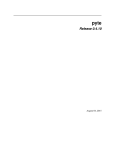
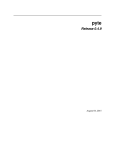

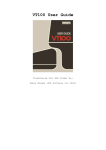

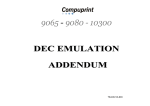

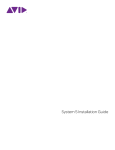
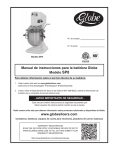

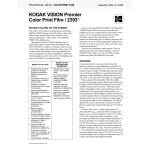
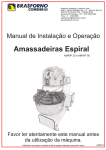
![System 5 v5.3 Release Notes - akmedia.[bleep]digidesign.](http://vs1.manualzilla.com/store/data/007435483_1-869dfe736550f807afef326210c3426b-150x150.png)
